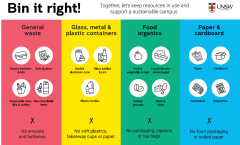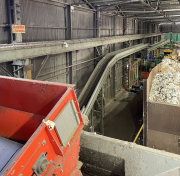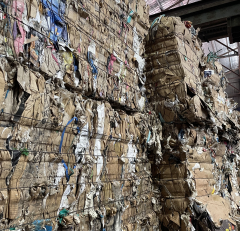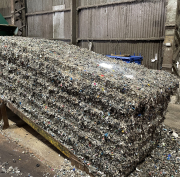Use this guide to know what to put in the bins and where it is processed once it leaves our campuses.
Which bin to use?
Outdoor bins
This bin only accepts uncrushed and labelled drink containers eligible under the Return & Earn Container Deposit Scheme:
- Plastic bottles (lids on)
- Small glass bottles (lids on)
- Aluminium and steel cans
- Juice boxes
To use the smart bin correctly:
- Empty your drink container
- Scan the barcode on your container
- If the bin lid open, drop your container in the bin.
- If the bin lid doesn’t open, your item is not eligible. Dispose it to the closest red bin.
Items placed in this bin are sorted at a material recovery facility.
Use the red bin for:
- Takeaway food containers (including compostable ones made with paper fibre or bamboo) and lids
- Takeaway hot and cold drink cups and lids (including compostable)
- Cutlery, chopsticks and straws (including those made from plastic or bamboo)
- Paper towels, serviettes and tissues
- Soft plastics (plastic packets, bags, wrap, and wrappers)
- Broken glass and crockery
- Food waste (you can also recycle your food waste in the green food organics bins available in your offices or at the dishwashing facilities listed on the Sustainability Map).
DO NOT use the red bin for:
- Construction and demolition waste
- Hazardous materials (gas bottles, solvents, paints and oils)
Remember, the best waste is no waste! Check Reduce waste and reuse at UNSW to reduce waste on campus.
Offices and kitchens
Download the “Bin it right” poster for your office here.
Items placed here go to a recycling facility.
Use the yellow bin for the following empty containers:
- Steel and aluminium cans
- Glass bottles and jars (lids on)
- Plastic bottles: soft drinks, water, juice or milk (lids on)
- Plastic containers for cleaning products
- Clean aluminium foil (scrunch into a fist sized ball) and trays
- Aerosol cans
Keep an eye out for the Australasian Recycling Label to check if your item can be recycled.
DO NOT use the yellow bin for:
- Food waste (use the green bin)
- Paper and cardboard (use the blue bin)
- Soft plastics: plastic packets, bags, wrap, and wrappers (use the red bin. Find clear soft plastic drop off points on the Sustainability Map)
- Takeaway hot and cold drink cups and lids (use the red bin)
- Compostable and bioplastic (Biopak) packaging (use the red bin)
- Paper towels, serviettes and tissues (use the red bin)
If your item can’t go in the yellow lid bin, check if it can be recycled in other ways.
Unsure what goes in? Use the red bin to prevent contamination of the recycling stream.
Most paper and cardboard is recyclable as long as it’s clean and dry.
Use the blue bin for:
- Office paper
- Newspapers, magazines and advertising material (remove plastic wrapping)
- Cardboard
- 100% paper gift / wrapping paper (i.e. no foil, glitter finishes)
DO NOT use the blue bin for:
- Takeaway hot and cold drink cups and lids
- Foiled lined or plastic-coated cartons
- Milk or juice cartons
- Fibre food containers
- Paper towels, serviettes and tissues
Unsure what goes in? Use the red bin to prevent contamination of the recycling stream.
(This waste stream is currently available at Kensington and Paddington campuses).
Help us turn food scraps into a nutrient-rich resource and energy by using the green bin.
Use the green bin for:
- Fruit and vegetable scraps
- Food leftovers (place the packaging in the red bin)
- Coffee grounds
- Meat & dairy leftovers
DO NOT use the green bin for:
- Food packaging, cutlery and chopsticks, including compostable and bioplastic packaging
- Takeaway hot and cold drink cups and lids
- Tea bags
- Soft plastic
- Paper towels, serviettes and tissues
Place all those items in the red bin instead.
Unsure what goes in? Use the red bin to prevent contamination of the composting stream.
Items placed in this bin are sorted at a material recovery facility (add a link to the section “Where does it go?”.)
Use this bin for:
- Takeaway food containers (including compostable ones made with paper fibre or bamboo) and lids
- Takeaway hot and cold drink cups and lids (including Biopak)
- Cutlery, chopsticks and straws (including those made from plastic or bamboo)
- Paper towels, serviettes and tissues
- Soft plastics (plastic packets, bags, wrap, and wrappers)
- Broken glass and crockery
DO NOT use this bin for:
- Hazardous materials (gas bottles, solvents, paints and oils)
- Food waste (where a green food organics bin is available)
- Paper & cardboard (where a blue bin is available)
Remember, the best waste is no waste! Check Reduce waste and reuse at UNSW to reduce waste on campus.
Where does it go?
Did you know? In 2023, UNSW generated 2,264 tonnes of waste. That’s equivalent to the average weight of 412 adult elephants.
Managing this waste responsibly is a key focus. With this aim, the University has defined two targets:
- Divert at least 85% of general waste from landfill
- Reduce general waste weight by 20% compared to a 2018 baseline.
Read below to find out where each waste streams go to increase material recovery and landfill diversion.
The contents of general waste bins are collected and processed by Doyle Bros at a material recovery facility in Fairfield East. Here, the waste is crushed into small pieces and mechanically sorted into four main streams to maximise resource recovery:
- Paper and cardboard: Recycled by Opal into new paper pulp and packaging.
- Metals: Recycled by Sell & Parker and Sims Metals to create new equipment.
- Processed Engineered Fuel (PEF): PEF is primarily used in industrial operations to replace fossil fuels like coal. It is currently used in cement plants in Japan, helping to reduce coal consumption. There is growing potential for its use in Australian cement plants shortly.
- Landfill: Only non-recyclable materials (such as crushed glass, food organics, and construction waste) are sent to landfill.
Using this process, UNSW is getting closer to our goal of diverting 85% of general waste from landfills. The below shows the weight percentages of waste diversion achieved in 2024:
- 35% of paper and cardboard
- 4% of metals
- 3% of plastic
- 42% recovered as PEF
- Only 16% of the general bin's total weight was sent to landfills.
Food organics collected from office spaces and back-of-house operations are sent to the EarthPower plant in Western Sydney. This facility uses an anaerobic digestion process to convert food waste into digester gas, which generates electricity to power the plant and supply energy for up to 4,000 homes. The process also produces a nutrient-rich sludge, which is dried and granulated into a soil improver suitable for commercial agricultural and horticultural use.
The items placed in office yellow bins are recycled in Smithfield by Visy:
- Glass is sorted by colour and recycled into new glass bottles and other compatible glass products.
- Metals (steel and aluminum) are recycled into new metal products after a smelting process.
- Hard plastic is chipped and cleaned before being recycled as rPET or rHDPE plastics, use to manufacture new bottles.
Paper and cardboard collected in office and classroom goes to a paper mill in Botany for recycling into new paper pulp and packaging.
The items placed in office yellow bins are recycled in Smithfield by Visy:
- Glass is sorted by colour and recycled into new glass bottles and other compatible glass products.
- Metals (steel and aluminum) are recycled into new metal products after a smelting process.
- Hard plastic is chipped and cleaned before being recycled as rPET or rHDPE plastics, use to manufacture new bottles.






